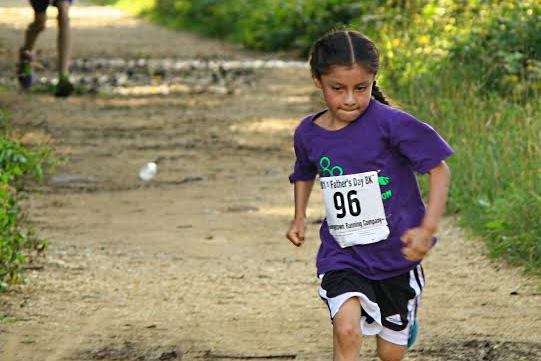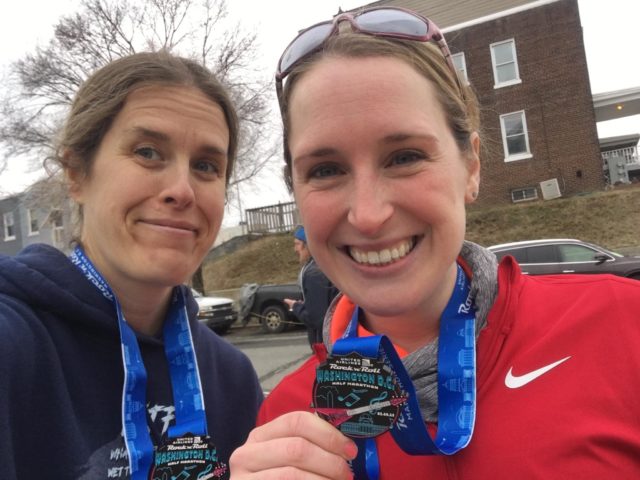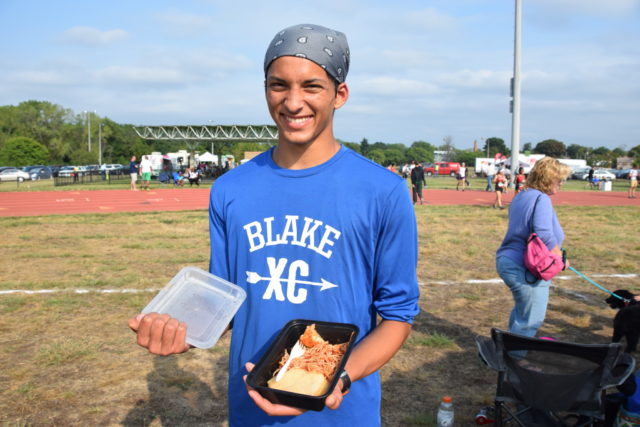
It started by accident, but before every race, Aaron Liiva makes sure he dabs a little bit of marinara sauce on his spikes.
He doesn’t use any particular type of sauce — although the Blake senior mentioned he’s partial to Costco’s Kirkland Signature brand. Usually, he just makes a point to save some of the sauce from his pre-race spaghetti.
It began earlier this year when Liiva spilled marinara sauce all over his uniform right before a race. But that day, he ran a 40-second PR. Since then, he’s added the ritual to his long list of pre-race routines, which also include placing an oak leaf in his right sock and wearing the same bandana.
“I have a lot of pre-race rituals,” Liiva said, pointing to his bandana. “I started wearing the bandana, so I don’t want to not wear the bandana because it might be bad.”
The field at Saturday’s DCXC Invitational was full of traditions and superstitions, but food was a common theme.
Matthew Owens, a senior at Quince Orchard, said the team always goes to the same restaurant — Noodles & Company — before each race.
“We’ve been doing it for so many years. It was done before we came in, so we decided to continue it,” he said, adding that he usually gets the Wisconsin Mac & Cheese. “I’ve done well when I’ve had it.”
Owens’ teammate, Rene Mugabo, opts for 24 Chick-fil-A chicken nuggets.
“One time, my brother took me before county and I did really well, so I just kept eating it,” he explained.
Across Kenilworth Park, spectators could quickly tell which teams use music, huddles and team cheers to prepare to toe the start line.
For the last year, the Westfield boys have started each race the same way.
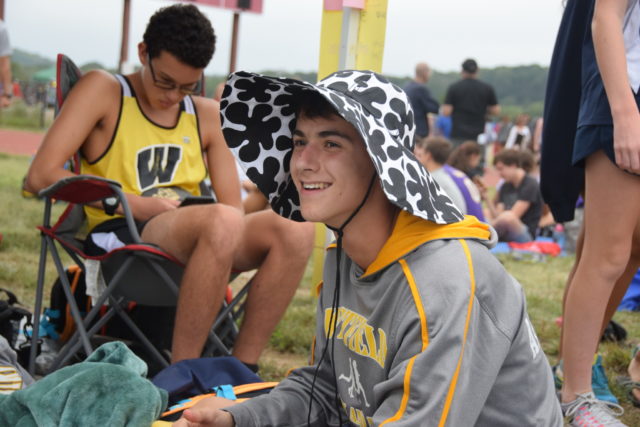
“We say, ‘Are you ready to get nasty?’ then we are like, ‘Yeah, we are!’ And we get a banana and throw it around,” said senior Colin Affterton, adding that they’ve dubbed “Cooking By The Book” — a rap remix of a song from a kids’ show — as the official team song.
Whether any of it helps them run faster is up for debate.
“We just have a lot of fun doing it,” he said.
The Blake girls have a similar ritual.
“We’ll scream, ‘Who are we?’ and the answer is, ‘Blake XC!'” said Claire Jacobs, a junior.
Eric Bartley, also a junior at Blake, gets hyped up before every race by listening to “Our Song,” by Taylor Swift.
“It’s actually a great song,” he explained. “I get in that moment where I feel like I can run forever.”
On the flip side, Bartley’s teammate, Jack O’Grady, has his go-to playlist of hard metal.
“It’s really intense stuff,” said O’Grady, adding that he always listens to the same songs in the same order. “I have to be kind of angry to run fast.”
For others, the start line offers a brief moment of calm before the excitement of the race.
“We always circle up and have a pre-meet talk and then we’ll say a prayer before we start,” said Logan Ali, a sophomore from Hempfield Area High School in Greensburg, Pa.
“Our coach always says to close our eyes and pictures ourselves as the champions,” said Junho Kim-Lee, a senior at Sidwell. “That’s something our coach has always done. And I like how he does that. I think it really helps to take a moment to think about how you want to run.”
Kim-Lee recalled how the tradition helped him in the early days of his cross-country career.
“I remember at my first race as a freshman. My whole body would be shaking. Even the day before, I couldn’t think. My thoughts would be scrambled,” he said. “But now I’m a lot more confident at the start line. It just helps focus on how you want to run.”
And then there are the runners who stick to their tried-and-true rituals out of fear changing them could be detrimental.
“I always wear the same tshirt and shorts the day of the race and I always bring an extra pair of socks and change into them like 10 minutes before the race,” said Sidwell senior Jordan Chernof. “It worked out once and now I’m too scared to change it up.”
“First, I have to crack my [right] hip. I can run without doing it, but it’s just something that I feel like I have to do. I started doing it my junior year and that’s when I started getting good at this,” said Maya Jacobson, a senior at Quince Orchard. “I’m also convinced that if I don’t wear this bracelet, something really bad is going to happen. The one time I didn’t wear this bracelet I put myself in the slow heat of the mile of indoor track and I ran really slow.”
For some, they rely on mantras and quotes to get them to the finish.
“I always think of this quote that my mama taught me,” said Blake senior Andy Otero. “It doesn’t really apply to cross country. It applies to when you’re being chased by a bear. It’s ‘Run faster than your friend.'”
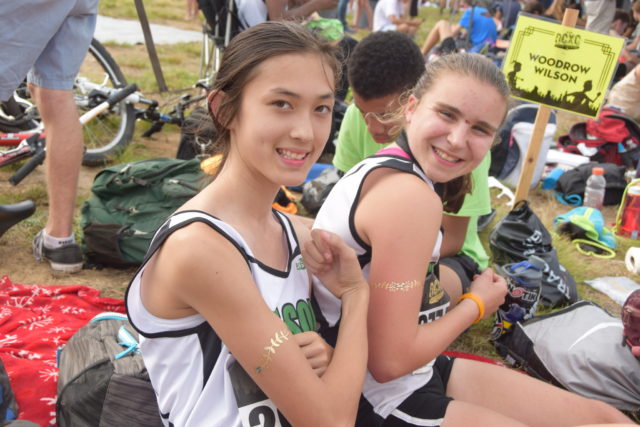
Ella Pearlman-Chang and Talia Lehrich, both freshmen at Woodrow Wilson, have only been on the team for a month, but they’re already thinking about establishing their own rituals for their high school cross-country careers. At Saturday’s race, they donned hair ribbons and matching temporary tattoos wrapped around their right arms.
“Our tradition is to do fun stuff before races,” Pearlman-Chang explained.
And then, of course, there are those whose only ritual is to not have any rituals.
“I don’t really believe in superstitions,” said Jason McFadden, a junior at Quince Orchard. “I don’t believe there’s anything you can do that’ll change the race other than train before. I don’t believe in those little charms. I found that tricking myself into thinking that these little things will make a difference kind of psychs me out and just makes me more nervous than I already am.”
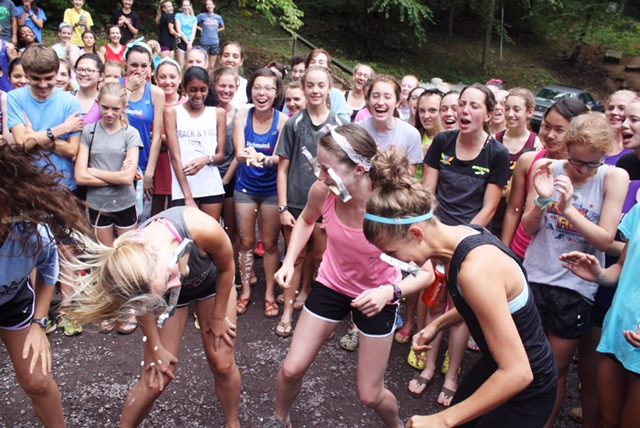 With summer finally here, many D.C.-area high schoolers are already looking ahead to the upcoming cross country season. Namely, ways to maintain their fitness levels during the off-season or to log additional training time to start the season off strong.
With summer finally here, many D.C.-area high schoolers are already looking ahead to the upcoming cross country season. Namely, ways to maintain their fitness levels during the off-season or to log additional training time to start the season off strong.
We spoke with several new and long-running camps — all of them different in their own unique ways — that offer athletes a chance to break the monotony of solo training runs and learn from elite coaches and staff while having fun away from home. From the camp that loves a killer game of ultimate Frisbee as much as it loves a good fartlek, to the camp that touts its urban backdrop, there’s something for everyone this summer.
The Everyman Camp
American Running Camp’s history dates back more than two decades to the University of Oregon, over 3,000 miles away from the camp’s home in Portsmouth, R.I. Legendary Ducks coach Bill Dellinger — who trained stars like Steve Prefontaine and Alberto Salazar — started the camp based on his successful “Oregon System” of distance running.
“Lectures, workouts and runs are all based on these principles — moderation, progression, adaptability, variation and callousing — and teaching campers these principles,” said Kerri Gallagher, assistant camp director, adding that co-camp directors Matt Centrowitz and Pat Tyson both ran for Oregon under the tutelage of Dellinger in the 1970s.
The staff at American Running Camp, which will take place Aug. 1-6 on the campus of Portsmouth Abbey School, is a diverse mix of Olympians, high school and college coaches, and elite post-collegiate athletes.
“We have a lot of different perspectives [from coaches and staff] having different backgrounds,” explained Gallagher, who represented Team USA at the 2015 World Championships in Beijing. “We can relate to a lot of different kids, whether trying out for cross country for the first time or the runner going into senior year and top in the state and looking to have a big season coming up. I think we’re very versatile in that way.”
Aside from its incredibly experienced staff, what sets American Running Camp apart is the fact it is open to athletes of all ages and abilities from middle and high school students to adults. Campers are assigned to running groups based on their current ability and mileage background, but have the flexibility to move groups as needed. The typical day is structured around a morning run followed by a meal and strength or stretching sessions such as yoga, core or hurdles. After lunch and some free time, athletes have the option to head out for a second run depending on their ability.
“We’re very aware that every runner is at a different place at that point during the summer,” Gallagher said.
Each day ends with a fun evening activity. At the close of camp, runners participate in a casual, non-competitive race as a way to gauge their fitness level and abilities heading into the official cross country season.
Additional perks of American Running Camp include on-site housing in Portsmouth Abbey School’s dormitories and a fully staffed dining hall that is very accommodating of dietary needs, Gallagher said.
The Urban Camp
This July, Pacers Running’s DCXC Distance Project will hold its first summer cross country camp, DCXC Camp, on the campus of Georgetown University. Athletes will get a taste of being a Washingtonian runner over the four days (July 23-27), including running through Rock Creek Park, Glover-Archbold Park and along the C&O Towpatch, participating in the Crystal City Twilighter 5K and exploring the National Mall and Smithsonian museums.
“This is the only camp that I know of that highlights it as an urban camp experience. It’s a unique feature,” said Landon Peacock, assistant manager at Pacers 14th Street and the camp’s director.
The day-to-day structure of DCXC Camp will be modeled after the 42-year-old Wisconsin Cross Country Camp of Champions, where Peacock, a two-time all American from the University of Wisconsin-Madison, worked for five years. The camp will feature clinics on strength and conditioning, injury prevention, form and gait analysis, and running workouts. Most notably, campers will have one-on-one contact with runners who have competed at the collegiate, professional and Olympic levels.
“What makes camps [like Wisconsin] good is the counselors and how much they’re willing to engage with the kids,” Peacock said, adding that Julie Culley, a 2012 Olympian and Arlington resident, is booked as a guest speaker. “[DCXC Camp] will be a good combo of fun activities and something they’re going to learn and take from the camp to use throughout their running careers.”
In addition, campers will stay in Georgetown University’s Southwest Quad dorms and have access to the facilities at Yates Field House, which includes a 200-meter indoor track, eight-lane pool, weight room, tennis courts and more.
The “Un-Camp”
Nestled in the scenic Blue Ridge Mountains of Madison, Va., Camp Varsity Running Camp has been churning out state champions, All-Americans and record holders for nearly 35 years. Although it’s almost 100 miles from Washington, the camp has extremely local roots and attracts many area runners. Its founder — then George Mason University coach John Cook — started the camp in the early 1980s and operated it for several years with George Watts, an All-American out of the University of Tennessee and native of Alexandria, Va. Today it’s run by Bob Digby, head track and field coach at Lake Braddock High School.
During Camp Varsity Running Camp, which this year will run from Aug. 14 to 20, athletes are up early for the first run of the day, followed by breakfast, a morning recreational activity like volleyball or ultimate Frisbee and then free time at the waterfront and on-site country store. After lunch, campers have an opportunity to squeeze in a nap before an afternoon run, followed by more free time, dinner and a fun evening activity such as capture the flag. At the end of the week there is a camp-wide relay where the victors are awarded an ice cream party.
Despite Camp Varsity Running Camp’s illustrious reputation and staff, noticeably missing from its schedule are the numerous lectures and speakers found at other running camps.
“Our camp is extremely different because the focus doesn’t necessarily rely around intense training. We spend a considerable amount of time on non-running things,” explained Bob Digby, director of Camp Varsity Running Camp. “I’m a believer that kids are not in great shape in August and if you take those kids and pound them for a week, you’re going to send them back to their coaches broken.”
While it may seem like an unproductive concept, Camp Varsity Running Camp is a disruptor by design — borrowing some of the “fun, goofy activities” from the six-week recreational camp, simply named Camp Varsity, that precedes it. And Digby, who has worked at the running camp since 1983 before taking it over 12 years later, has no plans to change its philosophy of fun.
“Our camp focuses on the recreational, fun part of it. It affords kids the opportunity to be kids, [especially for] juniors and seniors who are stressed out about college,” he said, adding that many of Lake Braddock’s coaches opt also to coach at the summer running camp, giving their teams a chance to see them in a “non-coaching role,” goofing around and dressing up silly for dinner. “That’s such an important thing for kids to have and they just don’t get at that age. It’s nice to be able to provide that.”

For Hiruni Wijayaratne, the last six years have been a whirlwind adventure. The track star — who won a 3,200m state championship as a junior at Herndon High School — is now eyeing the chance to represent her native Sri Lanka at the IAAF World Championships in Beijing this August.
Although her career at the marathon and half marathon distances has been brief — only spanning about six months — it’s been wildly successful. Last October, she was the first-place female finisher at the Evansville Half Marathon in Indiana. A month later, her debut marathon in Indianapolis — where she clocked 2:43:35 — was just seconds shy of making the marathon trials-qualifying cut for the 2016 U.S. Olympic Trials. It was fast enough, however, to qualify to compete as part of the Sri Lankan national team.
But the excitement of qualifying has been somewhat clouded by immigration regulations both at home and in a country nearly 9,000 miles away. Like millions of other immigrants, Wijayaratne renounced her native citizenship upon becoming a U.S. citizen last year. Now, to solidify her place on the Sri Lankan World Championships team, Wijayaratne needs to become a dual citizen of Sri Lanka — which has been an extensive process.
“The Sri Lankan government was willing to consider me a ‘special case’ and accept a request for dual citizenship. Then the Sri Lanka elections occurred [in January], a new president stepped into office and, since, the political agenda and regulations have been a mess,” she explained. “They are now requesting double the application fee — which is a lot of money — and to summon a special committee to review any application, which is taking a very long time.”
Wijayaratne has spent the last 15 years away from the country, making her a relatively unfamiliar face in the Sri Lankan athletics scene. She has several Sri Lankan national records pending in the half-marathon, 15k and 10k, and did receive positive press when a national newspaper, The Sunday Times, wrote about her stellar performance at the Monumental Marathon in Indianapolis. But her best chance to make the team is to do well at her first Boston Marathon appearance on April 20, when she’ll toe the start line with the elite women.
“I hope to run fast enough in Boston for my ‘net worth’ in athletic terms to increase, which should lead to an expedited [dual citizenship] process,” she said, adding that she expects to know the Sri Lanka Athletics Association’s final decision shortly after the Boston Marathon. Despite the high stakes, Wijayaratne is thrilled just to be competing in the iconic race.
“Boston will be my first time in a race of that caliber,” she said. “I’m in the elite field and I’m ecstatic. I don’t know how that happened.”
Wijayaratne humbly credits her success as “beginner’s luck,” but Pete Sherry, her coach at Herndon, knew she had the potential to be a great runner since she took her first lap around the track back in the fall of 2005, when she was just a freshman.
Sherry, who won silver in the World University Games in 1991 and qualified for the U.S. Olympic Trials three times, credits her success to talent and consistent training. He coached her for four years in high school and, since then, they’ve stuck together. Sherry now coaches her via phone from her new home in Evansville. Although it comes with challenges, Sherry believes their decade-long relationship serves them well.
“I know her so well that we’ve clicked. I get her,” Sherry said. “Not being able to see her work out is the only real issue. There are times during training I may have given her more or less depending on how she looked. She is incredibly driven. To be able to handle this training, work full time and live in Evansville is amazing.”
Wijayaratne, who also received her MBA from the University of Kentucky in 2014, works approximately 60 hours each week as an executive team lead at Target, which she said is a demanding job, both physically and mentally. She spends roughly 90 percent of her workday on her feet. Couple that with running 80-100 miles a week and the lack of quality training facilities in Evansville, and Wijayaratne has a tough workload.
“This is where Pete Sherry excels,” she said. “He understands I can’t train like a professional marathoner because I’m not one. So we have figured out a way to squeeze in workouts wherever and whenever. There are days I run just before midnight to get the miles in that day! But, hey, what’s success without a little sacrifice?”
She and Sherry make it work, shifting workouts and rest days depending on her schedule each week. Wijayaratne logs 10 to 12 miles three times a week, with strength training and treadmill work on Thursdays. Her long runs of 16-22 miles typically land on Tuesdays — a bit “unorthodox,” she said, but allow her to get the recovery time she needs. Wijayaratne works every other weekend, so on her Saturdays off, she gets in a second workout.
Despite Wijayaratne’s unconventional schedule, she’s confident she’ll perform well in Boston later this month. Her goal is simple: just run faster than she did in Indianapolis. From there, she’s gunning for a spot on the 2016 Olympic marathon team in Rio de Janeiro, when she’ll be 25.
“I think the goal is feasible,” she said. “I’ve already run under 2:44 for the Sri Lankan team. But if for some reason it isn’t in the plan for this coming Olympic games, then Tokyo [in 2020] would be one of my last and best chances either for Sri Lanka or the U.S.”
Eritrea native Weini Kelati came out of nowhere to take high school running by storm
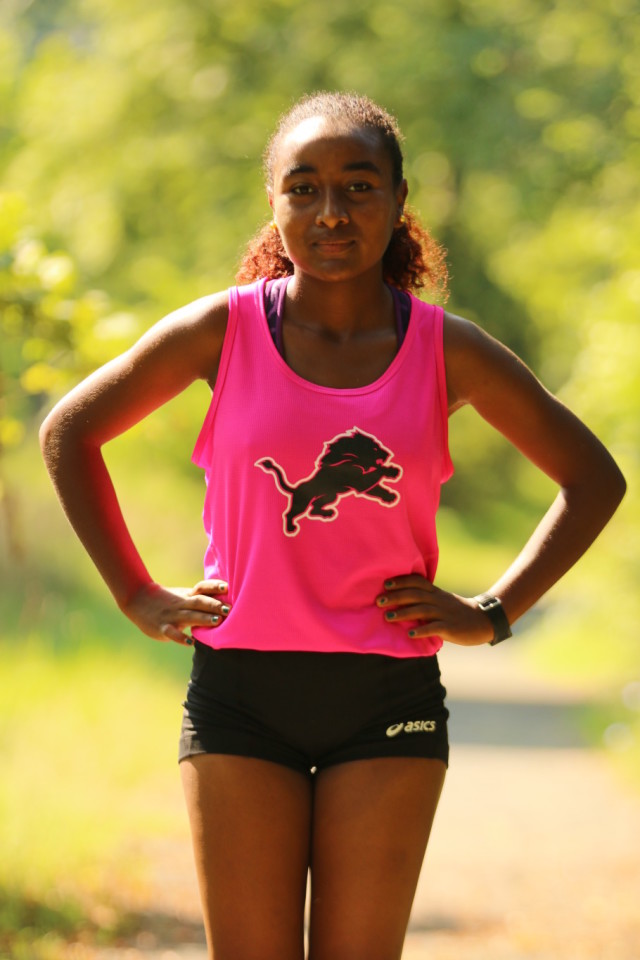
She blends in with her classmates at Heritage High School, constantly joking around and texting with her friends and cross country teammates. But Weini Kelati doesn’t share the same stories with her classmates about growing up in Leesburg, having shown up a year and a half ago from a country only her most geographically-astute classmates knew about — Eritrea.
Now a junior academically, the 19-year-old has been making headlines all school year as she nabs win after win, including the 2015 Foot Locker Cross Country Championships in December and a national high school record 16:08.33 for the 5000 meters at the New Balance Nationals Indoor in New York, two seconds faster than the existing record set my Anna Rohrer last year in 16:10.79. But her journey to become a champion — which began half a world away on the east coast of Africa — was not easy.
Coming to America
Eritrea borders Ethiopia and Sudan on the Horn of Africa. Therace she ever ran, she recalled, was in her sixth grade physical education class, and she hated it. But soon enough, her natural talent took over. At age 12, she already was a top-ranked runner in Eritrea, racing well outside of her age group and mixing it up with professionals in their 20s.
She competed at international meets across Europe as a teenager, but she was mostly unknown in the United States. In July 2014, at 17 years, Kelati ran 9:12.32 to finish eighth in the 3,000 meters at the at the IAAF World Junior Championships in Eugene, Ore.
Then, she didn’t go home. She applied for asylum and moved to Leesburg to live with her third cousin and now guardian, Amlesom Teklai, also an Eritrean immigrant and former competitive runner for West Potomac (Alexandria) in the late 1990s. Teklai, who first approached Heritage cross country coach Doug Gilbert, didn’t know he had a distant relative in Kelati until another family member in Texas asked him to take her in.
“[Amlesom] told me he just enrolled his cousin [at Heritage] and she loves to run. He mentioned she had just gotten back from the world championships,” Gilbert said. “It was at that point I Googled her name and very quickly found out who she was. It’s been a pretty large whirlwind since then.”
Kelati’s Eritrean Roots
Kelati doesn’t volunteer much about leaving Eritrea, spinning any question into a chance to talk about how excited she is to be in the United States, but it’s easy enough to find any number of reasons she’d be motivated to leave behind all she knew, her family, her friends.
Human Rights Watch calls the country’s record “dismal,” and the numbers — the United Nations estimates 5,000 émigrés flee the country every month — back that up.
Eritreans now make up the third-largest migrant group — behind Syrians and Afghans — trying to reach Europe. It’s a dangerous journey that requires crossing the borders into Ethiopia and Sudan, then on to Libya and across the Sahara. Finally, they must make the treacherous trip across the Mediterranean.
Many are leaving the country because of its forced military conscription. Eritreans are required by law to serve in the country’s military for 18 months when they reach 18 years of age, yet many remaining conscripted for 10 years or more while earning incredibly low pay that places an undue financial burden on their families.
Kelati shares a heritage with American Olympian Meb Keflezighi, whom she got to meet at the Foot Locker championships. But the two didn’t spend much time talking about the old country. “We both know about Eritrea so we didn’t need to talk about it,” she said, matter of factly.
That sums things up.
It’s been difficult, of course, to be thousands of miles removed from her family and friends. While Washington, D.C., has the second-largest African-born immigrant population in the U.S., the Eritrean community is undeniably small. But what she lost when she left Eritrea, she gained as part of a new family at Heritage.
A Strong Start
Fresh off an impressive finish at the World Junior Championships, Kelati had a strong start to her first cross-country season at Heritage. Despite stopping to tie her shoe not once, but twice, during the Oatlands Invitational in September 2014, Kelati maintained a 5:52 pace to win in 18:12.
“She was doing what I thought was like, ‘Wow, this is incredible stuff.’ I’ve had some incredible distance runners, but no one ever touched what she was doing,” Gilbert said.
But later in the season, her momentum began to fade. Battling a language barrier, Kelati struggled to explain the level of training she was accustomed to in Eritrea — and her fitness level suffered. She had been conditioned to run on Eritrea’s mountainous terrain, a drastic change from Northern Virginia’s grassy, rolling hills. Despite their best efforts, Gilbert and Kelati could not get aligned on her training. Though she made the national finals, she finished 20th. Given the excitement that surrounded her debut, it was a letdown, and to nobody more than Kelati.
“She speaks Tigrinya, a language most people probably never heard of. It was pretty nerve-racking. I did a lot of big arm motions and speaking loudly, which is not the right approach,” Gilbert said, laughing. “We could look at times and paces all day, but in terms of explaining why we’re doing certain workouts … it was tough last year.”
It wasn’t until they were returning from the state championships that November that Gilbert finally understood Kelati needed to be pushed harder than the rest of the team for her to stay on top.
“Everything was intense in Eritrea. There really was no such thing as a recovery day for her. Even on easy days, she was intense. I told her if we could get things together and work hard she could be the best runner in the United States,” Gilbert said. “I love how she races. I love the aggressiveness. She makes it a guts race. [But] her fitness level last year just didn’t suit that racing strategy.”
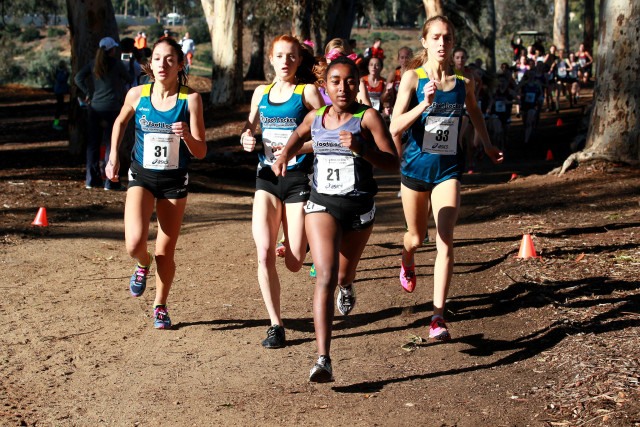
Becoming a National Champion
Over the next year, Kelati’s coach and teammates rallied around her, upping her training and helping her to learn English.
“This year, a major goal of ours was to tailor everything [Kelati] did, so she could race the way she wanted to,” Gilbert explained.
Teammates like Georgie Mackenzie used their workouts as an excuse to teach Kelati English. Others brought her an English dictionary and practiced with her during their lunch period, Kelati said.
“She’d teach me phrases in Tigrinya,” Mackenzie recalled. “And we just kind of got along like that. As soon as I met her, I automatically wanted to help her.”
Once Kelati’s English flowed more easily, so did her gradual return to the top of the leaderboard. In her second cross country season at Heritage, she once again placed first at the Oatlands Invitational, though this time even faster than before (17:11), blowing past the second-place finisher, the same runner as the year before, by 72 seconds. Then in October, Kelati took home the title
at the Glory Days Invitational, dipping under 17 minutes for the first time and leaving Lake Braddock junior Kate Murphy, who later won the state 6A title, in her wake.
Here is how she summed up her strategy: “I don’t think about who I am running against, if they want to come with me they can,” she said after Glory Days. “I just want to run fast.”
“She’s just going to hammer,” Gilbert added. “I can try to tell her to do something else, but she’s just going to do it.”
Nowhere was that more apparent than at the Foot Locker meet, a race she came into undefeated. Opening a several-seconds lead early on, Kelati was eventually swallowed by a chase pack. Even then she refused to let anyone else dictate the pace — she was going to run the race on her terms, and that did not include drafting and saving her energy. She fought back to the front and ahead of Illinois’ Maryjeanne Gilbert to win by less than one second.
She was a national champion of a country that was still new to her.
The Road Ahead
As Kelati prepares to enter her final year of high school this fall, she wraps up her last year of eligibility to compete for Heritage. She plans to focus on academics and getting into college — a goal echoed by Keflezighi.
“He told me to just be strong,” Kelati said. “And to get a good education. And after, when I’m done [with college], I could become a faster runner. But first I have to get my education.”
Kelati will undoubtedly make appearances in the Washington-area racing scene throughout the year to stay in shape, but will continue to focus her training on the 5k and 10k. Eventually, she wants to transition to competing in half marathons and marathons — maybe even gunning for a spot on the Olympic team.
“My dream is to run the marathon in the Olympics,” she said.
This article originally appeared in the Spring 2016 issue of RunWashington.
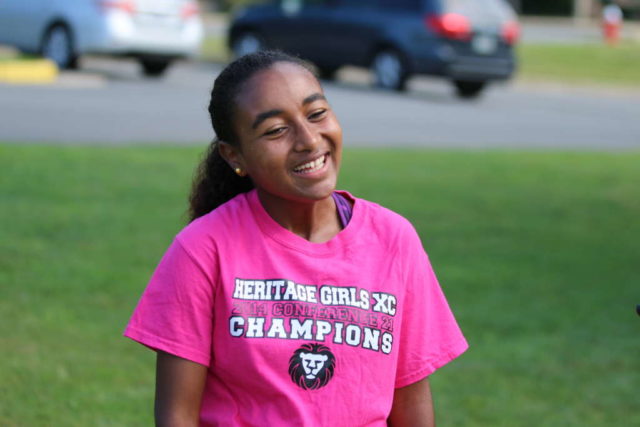
She blends in with her classmates at Heritage High School, constantly joking around and texting with her friends and cross country teammates. But Weini Kelati doesn’t share the same stories with her classmates about growing up in Leesburg, having shown up a year and a half ago from a country only her most geographically-astute classmates knew about — Eritrea.
Now a junior academically, the 19-year-old has been making headlines all school year as she nabs win after win, including the 2015 Foot Locker Cross Country Championships in December. But her journey to become a champion — which began half a world away on the east coast of Africa — was not easy.
Coming to America
Eritrea borders Ethiopia and Sudan on the Horn of Africa. The first race she ever ran, she recalled, was in her sixth grade physical education class, and she hated it. But soon enough, her natural talent took over. At age 12, she already was a top-ranked runner in Eritrea, racing well outside of her age group and mixing it up with professionals in their 20s.
She competed at international meets across Europe as a teenager, but she was mostly unknown in the United States. In July 2014, at 17 years, Kelati ran 9:12.32 to finish eighth in the 3,000 meters at the at the IAAF World Junior Championships in Eugene, Ore.
Then, she didn’t go home. She applied for asylum and moved to Leesburg to live with her third cousin and now guardian, Amlesom Teklai, also an Eritrean immigrant and former competitive runner for West Potomac (Alexandria) in the late 1990s. Teklai, who first approached Heritage cross-country coach Doug Gilbert, didn’t know he had a distant relative in Kelati until another family member in Texas asked him to take her in.
“[Amlesom] told me he just enrolled his cousin [at Heritage] and she loves to run. He mentioned she had just gotten back from the world championships,” Gilbert said. “It was at that point I Googled her name and very quickly found out who she was. It’s been a pretty large whirlwind since then.”
Kelati’s Eritrean Roots
Kelati doesn’t volunteer much about leaving Eritrea, spinning any question into a chance to talk about how excited she is to be in the United States, but it’s easy enough to find any number of reasons she’d be motivated to leave behind all she knew, her family, her friends
Human Rights Watch calls the country’s record “dismal,” and the numbers — the United Nations estimates 5,000 émigrés flee the country every month — back that up.
Eritreans now make up the third-largest migrant group — behind Syrians and Afghans — trying to reach Europe. It’s a dangerous journey that requires crossing the borders into Ethiopia and Sudan, then on to Libya and across the Sahara. Finally, they must make the treacherous trip across the Mediterranean.
Many are leaving the country because of its forced military conscription. Eritreans are required by law to serve in the country’s military for 18 months when they reach 18 years of age, yet many remaining conscripted for 10 years or more while earning incredibly low pay that places an undue financial burden on their families.
Kelati shares a heritage with American Olympian Meb Keflezighi, whom she got to meet at the Foot Locker championships. But the two didn’t spend much time talking about the old country. “We both know about Eritrea so we didn’t need to talk about it,” she said, matter of factly.
That sums things up.
It’s been difficult, of course, to be thousands of miles removed from her family and friends. While Washington, D.C., has the second-largest African-born immigrant population in the U.S., the Eritrean community is undeniably small. But what she lost when she left Eritrea, she gained as part of a new family at Heritage.
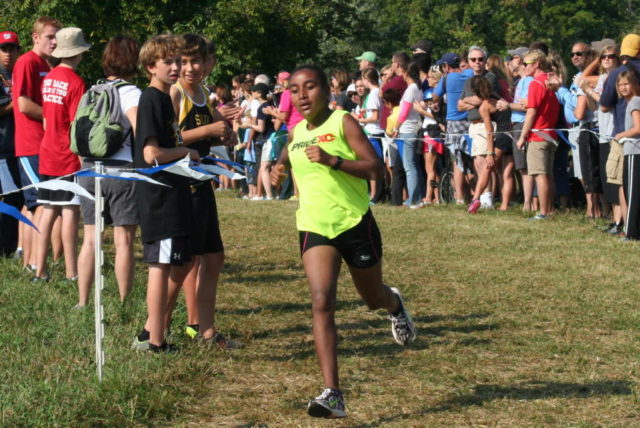
A Strong Start
Fresh off an impressive finish at the World Junior Championships, Kelati had a strong start to her first cross-country season at Heritage. Despite stopping to tie her shoe not once, but twice, during the Oatlands Invitational in September 2014, Kelati maintained a 5:52 pace to win in 18:12.
“She was doing what I thought was like, ‘Wow, this is incredible stuff.’ I’ve had some incredible distance runners, but no one ever touched what she was doing,” Gilbert said.
But later in the season, her momentum began to fade. Battling a language barrier, Kelati struggled to explain the level of training she was accustomed to in Eritrea — and her fitness level suffered. She had been conditioned to run on Eritrea’s mountainous terrain, a drastic change from Northern Virginia’s grassy, rolling hills. Despite their best efforts, Gilbert and Kelati could not get aligned on her training. Though she made the national finals, she finished 20th. Given the excitement that surrounded her debut, it was a letdown, and to nobody more than Kelati.
“She speaks Tigrinya, a language most people probably never heard of. It was pretty nerve-racking. I did a lot of big arm motions and speaking loudly, which is not the right approach,” Gilbert said, laughing. “We could look at times and paces all day, but in terms of explaining why we’re doing certain workouts … it was tough last year.”
It wasn’t until they were returning from the state championships that November that Gilbert finally understood Kelati needed to be pushed harder than the rest of the team for her to stay on top.
“Everything was intense in Eritrea. There really was no such thing as a recovery day for her. Even on easy days, she was intense. I told her if we could get things together and work hard she could be the best runner in the United States,” Gilbert said. “I love how she races. I love the aggressiveness. She makes it a guts race. [But] her fitness level last year just didn’t suit that racing strategy.”
Becoming a National Champion
Over the next year, Kelati’s coach and teammates rallied around her, upping her training and helping her to learn English.
“This year, a major goal of ours was to tailor everything [Kelati] did, so she could race the way she wanted to,” Gilbert explained.
Teammates like Georgie Mackenzie used their workouts as an excuse to teach Kelati English. Others brought her an English dictionary and practiced with her during their lunch period, Kelati said.
“She’d teach me phrases in Tigrinya,” Mackenzie recalled. “And we just kind of got along like that. As soon as I met her, I automatically wanted to help her.”
Once Kelati’s English flowed more easily, so did her gradual return to the top of the leaderboard. In her second cross-country season at Heritage, she once again placed first at the Oatlands Invitational, though this time even faster than before (17:11), blowing past the second-place finisher, the same runner as the year before, by 72 seconds. Then in October, Kelati took home the title at the Glory Days Invitational, dipping under 17 minutes for the first time and leaving Lake Braddock junior Kate Murphy, who later won the state 6A title, in her wake.
Here is how she summed up her strategy:
“I don’t think about who I am running against, if they want to come with me they can,” she said after Glory Days. “I just want to run fast.”
“She’s just going to hammer,” Gilbert added. “I can try to tell her to do something else, but she’s just going to do it.”
Nowhere was that more apparent than at the Foot Locker meet, a race she came into undefeated.
Opening a several-seconds lead early on, Kelati was eventually swallowed by a chase pack. Even then she refused to let anyone else dictate the pace — she was going to run the race on her terms, and that did not include drafting and saving her energy. She fought back to the front and ahead of Illinois’ Maryjeanne Gilbert to win by less than one second.
She was a national champion of a country that was still new to her.

The Road Ahead
As Kelati prepares to enter her final year of high school this fall, she wraps up her last year of eligibility to compete for Heritage. She plans to focus on academics and getting into college — a goal echoed by Keflezighi.
“He told me to just be strong,” Kelati said. “And to get a good education. And after, when I’m done [with college], I could become a faster runner. But first I have to get my education.”
Kelati will undoubtedly make appearances in the Washington-area racing scene throughout the year to stay in shape, but will continue to focus her training on the 5k and 10k. Eventually, she wants to transition to competing in half marathons and marathons — maybe even gunning for a spot on the Olympic team.
“My dream is to run the marathon in the Olympics,” she said.
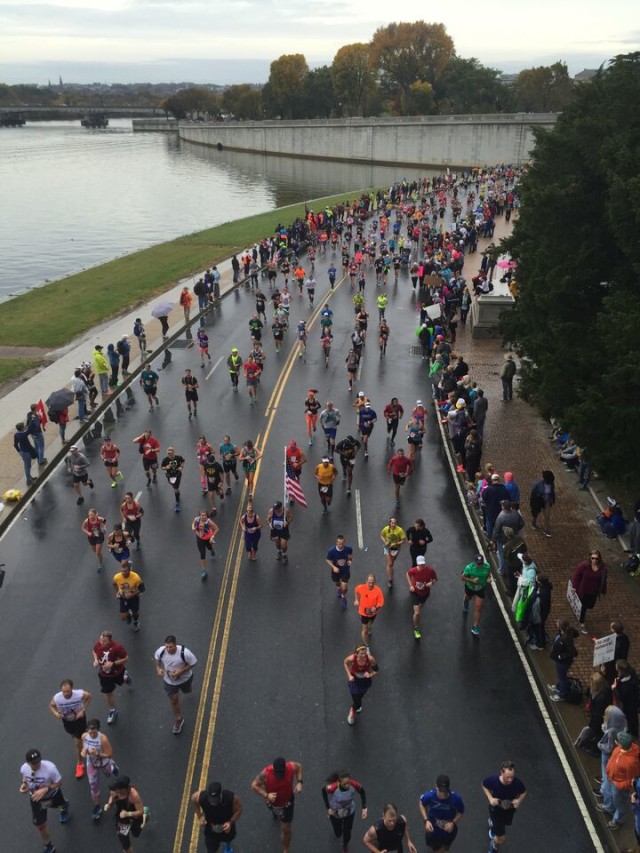
Sunday’s 40th Marine Corps Marathon started out on the wrong foot when rain and unusually long, slow security lines frustrated thousands of runners, but fortunately, it’s not how you start a marathon, it’s how you finish.
The 23,217 finishers made it the third-largest in the race’s history, with 4,438 coming from the immediate D.C. area.
Participants took to Twitter to share their frustration about Washington’s iconic race, tweeting things like “8 minutes after start time and 10,000 people still stuck at security. B-team running MCM this year” (@EdLuna) and “@Marine_Marathon you have a huge group of runners stuck at the entrance. You should be better than this” (@iRunFitDC).
“I was in line at security at 0620. I did not get through security until 7:20,” said Mike Stickley, a former Marine from Springfield, Va. “This was the worst because I was still late for the opening and had to rush to the start line and bag drop. I didn’t really even get to stretch. That debacle needs to be fixed, and I understand it’s for our security and wellbeing, but seriously, metal detectors for people who are going to run a race with clear bags.”
The metal detectors were a new feature, suggested well ahead of time by Arlington County Police, according to MCM spokeswoman Tami Faram, and not set up in connection to a specific security threat.
“It was just another layer of security that local law enforcement suggested we take,” she said. “we didn’t take people’s bags, we didn’t take their personal hydration packs,” a reference to Boston Marathon security measures ahead of its pre-race athletes’ village.
The backups at the checkpoints came as a result of backups on the Metro Blue Line, a larger-than-expected flow of runners walking from Rosslyn and malfunctions with some metal detectors, likely caused by the rain.
“They aren’t typically used outdoors, so next year we may have to have them under tents,” Faram said. “We’re reviewing everything to make next year’s event smoother. The Metro backup, I think there was a deer on the tracks, meant we eventually had a huge bottleneck at the checkpoints.”
The scene eventually resembled an airport on a major holiday, which gave Kimi Vadnais, of South Carolina, a bad first impression. But, like so many others, Vadnais’ less-than-ideal start to the day took a backseat once she was out on the course. She was there for two reasons: to celebrate an early 40th birthday and to honor a family friend.
“This marathon was super special to me because I was running to honor an amazing young [man] that lost his life too early, Maj. Taj Sareen, a true American hero,” said Vadnais, whose husband worked with Sareen in VMFA-232, nicknamed the “Red Devils.” Sareen, a fighter pilot, was killed earlier this month when his plane crashed shortly after takeoff from Royal Air Force Lakenheath in England.
Everyone had his or her own reason to be at the start line on Sunday. This was Stickley’s third Marine Corps Marathon as a runner. But as a Marine, he said he used to work the race at the Hains Point turnaround while stationed at the Navy Yard.
Lisa Gallagher, of Arlington — or more specifically across the street from the finish line — planned to make the Marine Corps Marathon her “comeback to running” after a two-year hiatus. But an infected toenail less than three weeks before race day almost kept her from the start line.
“I had been training for Marine Corps and losing a couple toenails here and there,” Gallagher said, explaining how one of them became infected, causing redness and swelling in her foot and ankle. So she went to see a podiatrist.
“I opted for [the podiatrist] to stick me with a needle and remove the rest of my toenail. It was the best decision,” she said. “[My toe] looked the best the morning of Marine Corps. And I ran a PR. I love not having a toenail. I don’t want it back.”
Florida resident Tammy Landeen, who placed first in the women’s hand cycle race (1:58:01), was there to compete with her teammates from Paralyzed Veterans Racing (PVR).
“I joined PVR to regain that camaraderie that I lost when I was no longer in the military. And this race just completely solidified everything. It was such a positive and moving experience,” said Landeen, an army veteran and first time Marine Corps Marathon participant.
Both Adam Cook, of Arlington, and Eric Wildon, of Elkins Park, Pa., were there to check off a bucket list item. For Cook, he wanted to complete his first marathon. For Wildon, his first MCM.
“It’s one of those marathons that I had to do at some time in my life,” Wildon explained.
Unlike Wildon, Arlington resident Michael Naff, had already completed the Marine Corps Marathon several years before — and has a strict rule not to run the same marathon twice. But he made an exception for the MCM’s 40th anniversary.
For Al Richmond and Will Brown, running the 40th MCM was about keeping a legacy alive. Richmond and Brown are the only two remaining members of an elite club, known as the Groundpounders, who have run every single Marine Corps Marathon since its inception in 1976.
“I call it ‘a rite of fall,” said Richmond, who lives a block away from the course in Arlington. “But it is sort of a tradition now and I really would hate to break the ‘string.’”
Additional reporting by Charlie Ban.
Ashley Davidson is a public relations professional who recently chronicled the Tidal Basin Runs and has written for RunWashington since 2015.
Read more of her work here.
Name: Ashley Davidson
Self-described age group: 33 – an “older” millennial
Residence: Alexandria, Va.
Occupation: Public relations
Why you run: In my mid-20s, I ran because I was bored. When I hit 30, I needed the self-esteem boost. Now, I need to alleviate my back pain.
When did you get started running: I ran track in middle school, but then didn’t run again until I ran my first 5K at 23 (which I hated). My next 5K was in 2011 at age 25, and I’ve been running every since.
Have you taken a break from running: Only when the temperature drops below 15 degrees.
Training shoe: New Balance 880
The hardest race you’ve ever run: The first and only time I ran the Rock ‘N’ Roll Marathon in D.C. That second half was brutal, mentally.
Most adventurous decision you’ve made with your running: To run two marathons in three weeks. I never made it to the second one, due to injury. (Who would’ve thought…)
Running mentors: Scott Kaldahl, my coach from my first marathon, when I ran with Team in Training Miami.
My favorite place to run in the D.C. area is: Anywhere with shade.
Favorite local trail: I live near Holmes Run, so it has a special place in my heart.
My best race was: 2018 Chicago Marathon – huge props to anyone that pushed through that torrential downpour.
Favorite local race: Parkway Classic – I’m all about the downhill.
Ideal post-run meal: Depends on the day and the run, but guaranteed after a marathon I’ll want a cheeseburger – and a mimosa.
Favorite flavor of gel, gu, etc: Don’t use them.
Pet peeve: Cyclists that don’t ring their bell and scare the crap out of me as they zoom by.
Goals: Run a sub-4 marathon.
Your advice for a new runner: Get fitted for shoes.
Favorite running book: Wild – it’s about hiking, but I love that Cheryl Strayed took a (somewhat) solo journey on a section of the PCT to figure out her hot-mess life.
Song in your head during a run: I listen to audiobooks, so typically don’t have a song in my head.
Have you dealt with a major injury: IT band – chalk it up to being an over-eager, newbie runner.
Running quote: “If you don’t have answers to your problems after a four-hour run, you ain’t getting them.” (Born to Run)
Why is the D.C. area a great place to be a runner: The trail network and the incredible community.
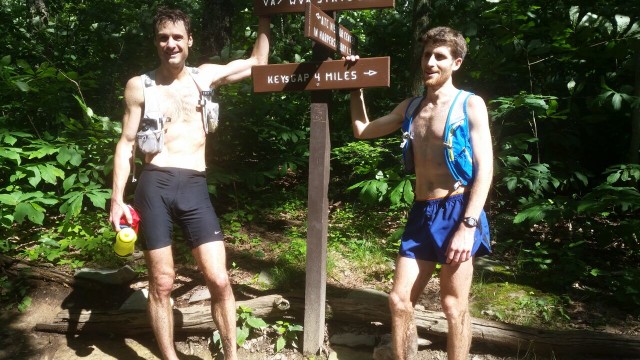
For many, hiking the Appalachian Trail is a rite of passage. Spanning 2,180 miles from Georgia’s Springer Mountain to Katahdin, Maine, the “A.T.” challenges even the most seasoned athletes with its untamable terrain and unpredictable elements.
Just 64 miles northwest of Washington lies Harpers Ferry, W.V., a small, historic town nestled in the Shenandoah Valley where West Virginia, Maryland and Virginia converge. It’s one of the few towns through which the Appalachian Trail runs directly. Just a few weeks ago, Dustin Meeker, of Baltimore, and Gaithersburg resident Conrad Laskowski descended upon Harpers Ferry for the second time that day, this time to celebrate completing the Appalachian Trail Four-State Challenge — a 42.9-mile trek traveling across the borders of Pennsylvania, Maryland, West Virginia and Virginia.
That moment was over two years in the making. Meeker, a lifelong runner and lover of the outdoors, had just finished reading the books A Walk in the Woods, Bill Bryson’s tale about walking the entire length of the Appalachian Trail, and The Longest Race, Ed Ayres’s exploration of ultramarathoning. Then, an idea sparked. He decided to merge his two passions and run a portion of the A.T.
After some research, Meeker set his sights on the Four-State Challenge. Laskowski agreed to join him.
Months passed and goal races kept the two competitive runners from fully committing to tackling the trail. But finally, on Sunday, June 28, the time came. At approximately 8:15 a.m., Laskowski and Meeker took off from Pen Mar Road in southern Pennsylvania. A wrong turn in the first few minutes set them a mile off course, but they quickly recovered and soon the pair crossed the Mason-Dixon Line into Maryland. It would be another 40 miles along the backbone of South Mountain until they reached another state line.
The first four miles were business as usual for Meeker and Laskowski, who have each been running for two decades, but then the trail abruptly ended and they came face-to-face with a boulder field.
“It was no longer a distinguishable trail. You just came out to an open space where the ground was just rocks on rocks on rocks,” he explained. “You’d scan the horizon to see a tree with white glaze on it to see where you were supposed to be going.”
Reluctantly slowing their pace to 14-minute miles, they crawled forward, carefully stepping from boulder to boulder, making sure each foot landed on something stable. One wrong move could be detrimental and force them to pack up and head home barely a tenth of the way into their planned route.
By A.T. standards, the Maryland portion of the Appalachian Trail is easy and serves as a gut check to see if hikers are ready for more rugged areas. During training, Laskowski said, simulating the trail’s rockiness wasn’t accomplished other than during a 20-miler — 10 out, 10 back — they ran on a segment of the trail. But significant rainfall the previous day now had slickened the already challenging technical terrain. Quiet streams now rushed. Once-dry rocks became miniature waterfalls.
But throughout their journey, difficult, unrunnable areas quickly transformed into blossoming meadows and scenic overlooks, allowing the runners brief moments of euphoria. The A.T. wrapped through lush state parks crawling with wildlife as Laskowski and Meeker continued southbound through Maryland, feeling strong. Both were marathoners, so despite the stark difference in terrain from their typical road races, the amount of time on their feet was old hat. But beyond that, it was uncharted territory.
Just shy of the 50k mark, both Meeker and Laskowski hit a wall — hard — as they began an estimated one-mile climb up the side of a ridge.
“I went into a dark place,” Laskowski explained. “I convinced myself I was going to have to pull the plug.”
They agreed that once they reached Gathland State Park, roughly 10 miles short of their goal, they’d call it quits. “Psychologically, I was broken down,” Meeker said.
Meeker’s girlfriend, Melissa, was waiting for them at Harpers Ferry. He reached into his pack for his phone to let her know to pick them up within the hour. But his phone was wet and he couldn’t send the text. Frustrated, they continued their climb. When they reached the crest, they were relieved to have a long, gradual descent over a much more forgiving portion of the A.T. That was the second wind they needed.
“[The feeling] is common among ultrarunners, but something we hadn’t experienced,” Meeker explained. “It’s common for people to go through very dark patches and suddenly come out of it and feel rejuvenated.”
They continued to run due south through Gathland State Park with their sights set on reaching Harpers Ferry. As Laskowski and Meeker approached the footbridge stretching across the Potomac, they paused to take in the view. They had finally reached West Virginia.
Only about four miles of the A.T. runs through West Virginia proper and the elevation remains relatively fl at. As the pair exited Harpers Ferry and crossed over the Shenandoah River, they knew they were only a few miles from achieving their goal.
But just before mile 41, the trail turned sharply upward, ascending nearly 875 feet in less than a mile and a half. Meeker and Laskowski battled exhausted legs up the seemingly never-ending side of the mountain in desperate search of the Virginia state line — their finish line. It was their most grueling climb of the day, after running nearly eight hours. They began asking hikers heading north how far they were from Virginia. Some estimated a mile. Others replied, “It’s not much farther.”
In the final stretch of the Four State Challenge, the trail runs parallel to the border with Virginia, almost taunting runners looking for the proverbial finish line. It was just within reach through the trees, but where exactly?
They pushed on.
Finally, after eight hours and five minutes, Meeker and Laskowski stepped into Virginia.
[button-red url=”http://mountainpeakfitness.com/blog/2015-fkt-at-4-state-challenge-iain-ridgway” target=”_self” position=”left”] Ridgway’s account[/button-red]After pausing to cherish their accomplishment, sweaty and muddied from 42.9 miles of trail running, the pair turned around and descended down the mountain back toward Harpers Ferry. They had covered more miles in a single day than many runners do in a week’s time. And they’re already started talking about a second go at the Four-State Challenge, this time in pursuit of the fastest known time of 7:29:51, set by ultrarunner Ian Ridgway earlier this year.
For Laskowski and Meeker, completing the challenge was a joyful moment together and a significant personal achievement for each. There were no spectators cheering them on in the last 100 meters or medals placed around their necks.
Despite the lack of fanfare, it was pure bliss.
“It’s one of the greatest feelings I’ve had as a runner,” Meeker said.
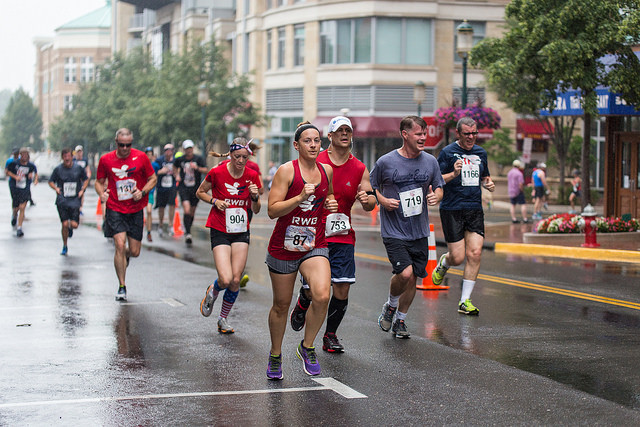
[button-red url=”http://s3.amazonaws.com/media.racebx.com/transfer/gen/5/5/9/5597e27f-9054-456c-9455-52afc0a86526/2015-Firecracker-Overall.htm” target=”_self” position=”left”] Results [/button-red]The crowd erupted as Abu Kebede Diriba and Gregory Mariano rounded the corner onto Market Street in the final 200 meters of the Firecracker 5k, Saturday at Reston Town Center. The men had pounded the wet pavement neck and neck for most of the race, and now cut through the rain in a fight to the finish. But after a quick glance over his right shoulder, Diriba, an Ethiopian marathoner living in New York, gave one final kick to cross the finish line in 15:30 — just one second ahead of Alexandria’s Mariano.
Ben Dickshinski, a senior at North Central College in Naperville, Ill., and an All-American in the 5000m this spring, placed third in the men’s race in 15:53.
While the worst of the morning’s rainstorm held off until most runners had finished, the weather still affected even the most seasoned athletes’ performance.
“My pace was not fast. It was difficult with the rain,” Diriba said through his coach and translator, Ayele Belete, of Silver Spring.
Fellow Ethiopian and marathon runner Elfinesh Melaku Yado agreed. Despite leading the way through the entire women’s race, she felt the rain slowed her down. She placed first in 16:35, while her closest competitors, Amsale Astatek and Tazeta Dengersa, both of Washington, finished in 16:42 and 17:24, respectively.
The sixth annual event has become a tradition for area families like the Delmolino family of Vienna. Wendy Delmolino signed up with her husband, Dominic Delmolino, and two children, Peter Delmolino and Francesca Delmolino.
“My husband and daughter started doing this [race] two years ago and we did it as a family last year. Now it’s a family tradition,” said Wendy Delmolino, who was joined by out-of-town friends, the Wartels.
“We happened to be here this weekend and we always do a 4th of July race,” explained Laura Wartel, of Westerville, Ohio.
Peter Delmolino was “pumped” to run the race that morning since he’s been training to run 5Ks in preparation for his first cross country season at South Lakes High School in Reston this fall. He finished in 24:47.
Camaraderie was an ongoing theme during the Firecracker 5K, which supports local military members and their families. Upward of 60 members from Team Red, White and Blue (RWB) — a nonprofit whose mission is to enrich the lives of veterans — attended, including Derek Mitchell, of Kansas City, whose story went viral earlier this year when the then 570-pound man committed to running a 5k each month in 2015.
“Our Team RWB crew got money together and actually flew him out, so he’s here today doing the Firecracker 5K with us,” said Gretchen Apgar, of Arlington. “[The race] brings everyone together. It’s a really great event — to see people we haven’t seen in awhile and meet other people in the community.”
For Brittaney Short, of Vienna, the Firecracker 5k was about making the 4th of July more than just a barbecue.
“I wanted to feel like I did something important today,” she said. “I wanted to do something for our troops.”
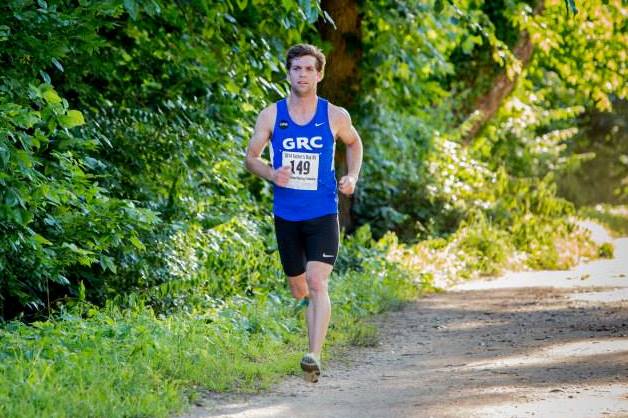
Ryan Witters was a little rusty, but muscle memory took over and powered him to his fourth consecutive Father’s Day 8k title on the C&O Canal Towpath in Georgetown.
He captured the title in 26:20 — smoking his nearest competitor, Matthew Deters of Arlington, by a full 50 seconds. Although slower than last year’s first-place finish of 25:38, Witters was happy with his performance.
“I was a little less in-shape than I was in previous years,” he said. “Normally, I just try to go out and run hard and fast. This year was a little different for me. I’m taking classes for my master’s degree at Maryland and spring semester really beat me up this year. I basically took all of spring off whereas normally I’m coming off of a track season. The strategy was just to go out there and finish it. Try to run as hard as I could.”
Fresh off a second-place finish at the Collegiate National Trail Running Championship a week before, George Mason alumna Bethany Sachtleben finished first in the women’s race, clocking 28:26. The recent George Mason grad finished a full two minutes ahead of Megan Haberle, of Washington, who, like many of the participants on Sunday, struggled with the heath and humidity of the summer solstice.
“I did well. I had pretty low expectations given the heat,” said Haberle, who finished second in 30:26. “I’m not a very talented heat runner, so I think I was just out there to survive the day. Just try to run a good race and push myself through it.”
For Alex Eversmeyer, of Ashburn, the heat gave him an opportunity to work on mental strength as much as finishing time as he gets back into racing following a knee injury.
“It was rough. But it’s a good challenge. I’ve been a very mentally strong runner in the past. I have it up here, it’s just a matter of applying it,” said Eversmeyer, who finished fourth in the men’s race in 29:38. “I am a strong mental runner, but the heat will take it out of you no matter who you are.”
For many runners, the Father’s Day 8k was a chance to get outside and spend some time with their families. The roles were reversed for Sachtleben on Sunday when she was the one cheering on her father, Doug Sachtleben, as he crossed the finish line.
“This is probably our once-a-year [race]. We follow her around and cheer her on when we can,” said Doug Sachtleben, who admits running doesn’t run in the family. “We were just looking for a summer race to do together.”
Chevy Chase native Catherine Beal ran the race for the second time with her father, Ashby Beal.
“It’s more than just the race,” she explained. “When I get home from college, we spend a month and a half training for it almost every day. So it’s a nice way to kind of hang out and spend time together.”
“I used to run when I was younger. And then I think I got older and thought my body couldn’t take it,” Ashby Beal added. “But with Catherine as my trainer and doing shorter runs and more realistic runs for my age, it’s actually kind of fun.”
Other participants return to the Father’s Day 8k year after year as a way to honor the memory of their fathers.
“My dad died 3 years ago unexpectedly. He was involved in a freak accident. I got that late night call everyone fears,” Jaime Andrews, of Washington, wrote on the event’s Facebook page. “On this day, I get a lot of anxiety. Seeing families celebrating and photos all over social media. This race has provided me a focus, an outlet and a way to celebrate my father each year. I enjoy the course, the community and intimacy of the race.”
The race also marked the end of National Men’s Health Week and Men’s Health Network was on-site to offer several health indicator tests.
“We want to tell men that they really need to pay attention to their overall health,” said Zak Hines, of Virginia Beach, who is attending American University for the summer and interning with Men’s Health Network. “One of the biggest things you can do to improve that health is exercise. Running is a great way to do it.”
